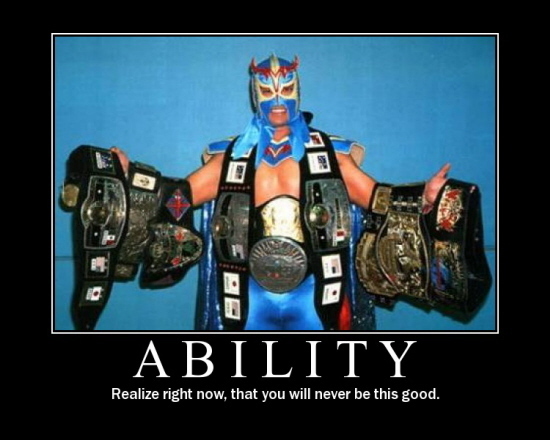SHOOTS IMITATE WORKS?
Legions of fans laud the likes of Jet Li and Bruce Lee as legitimate martial arts masters. This is not on the basis of Bruce Lee's little known high school boxing championship, nor of Jet Li's Wushu forms championship, it is purely on the strength of their performances on the big screen.
These performances, magnificent as they might be, are different in kind from the likes of which are put on by the Dean Malenko's, Bret Hart's, Chris Benoit's and Ultimo Dragon's of the world (all wrestlers whom are known to the public for technical acumen displayed in the worked environment). Jet and Bruce's myriad victories against innumerable odds and opponents are not merely "worked", they are rehearsed, edited and aided by special effects and camera angles. When Malenko and the Ultimo Dragon exchange Achilles tendon-locks, kneebars and toeholds before a live crowd, they are not guided by a director or choreographer, only by their own muscle memory. And more often than not, their dance--though predetermined--is also unrehearsed.

Yet where the likes of Jet Li still get praise for the skills put on display in their films (assumed by the teeming masses to be indicative of an ability to kick copious amounts of butt) and find themselves on the cover of such publications as Blackbelt Magazine, it is only through shoot accolades that professional wrestlers might ever find themselves on the cover of a "respectable" martial arts journal, regardless of the beauty or soundness of their technique.
Is it right to assume that even the most technical of professional wrestlers are, in the end, nothing more than entertainers? Evidence seems to suggest that they are not.
Obviously, there are people who did well as far as win-loss ratios in leagues such as the UWF, UWFi, Kingdom etc. (Japanese federations with an emphasis on technical wrestling and a high turnover to mixed martial arts) who didn't come off nearly as well in actual shoot environments.
But, there were also people, more to the point, who, in spite of having solid "pushes" in the aforementioned leagues, actually looked as if they were relative neophytes when it came to grappling--Takada, Sano and Anjoh being examples of this--and whereas in the case of others--such as Tamura, Funaki and Suzuki--the push they received in professional wrestling bouts was more or less on par with the level they ascended to as shoot performers.
In the cases of the latter-mentioned and to an extent, Ken Shamrock as well, they all displayed a high level of technical soundness, regardless of their pushes. I would argue that, in the case of Sano, Anjoh and Takada, in spite of their pushes, they didn't in fact, reflect in their matches a particularly sharp submission ability.
Their pushes, much like in Western professional wrestling, were owed to their knowledge of so-called ring psychology in generating emotions from the crowd and, in Takada's case, his personal charisma and his spectacular-looking kicks and suplays (which, despite requiring a deal of skill to pull off, demanded cooperation from his "opponent").
Although Sakuraba didn't really receive a major push in professional wrestling until his submission skills were put on display at Ultimate Japan, the actual content of his bouts--push or no push--seemed to indicate a man very articulate in grappling, with a wide arsenal of moves and a smooth and sound execution.
Of course, his mixed martial arts career indeed confirmed that, whatever criticisms you might make of the man, he was indeed a very, very able grappler. Even more, many of the moves he favored as a professional wrestler--the kneebar, the kimura, the low shot--also served him well as a mixed martial artist.
Based on this, it would seem that one could argue that professional wrestling bouts can serve as a gauge to at least make a strong educated guess as to a given performer's "shooting" capability, but characterizing such guesses as more than speculation would be premature before it is explored whether there were any exceptions, where a performer displayed a high-level of technical grappling ability in professional wrestling but a relatively low level of such in shoot environments, be it mixed martial arts, submission-grappling or amateur wrestling.
A search for such examples should be nuanced however, with the question as to whether or not the holes in a performer's grappling ability were not such that they could have been anticipated from his professional wrestling game. Such examples don't spring readily to my mind, though I wonder if the knowledgeable readership of Scientific Wrestling might know something I don't.
Let us know your thoughts; do shoots imitate works?